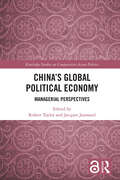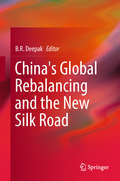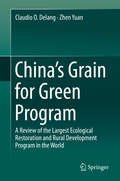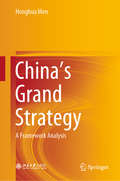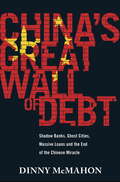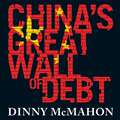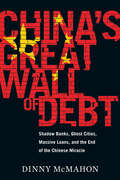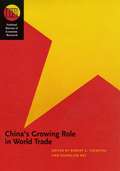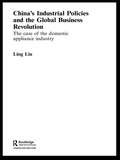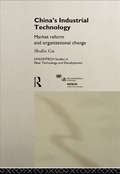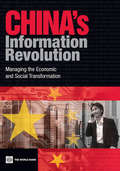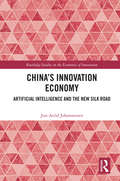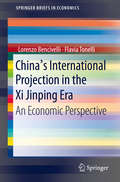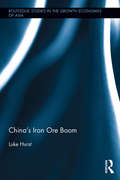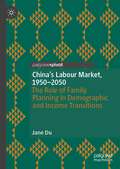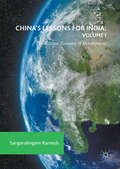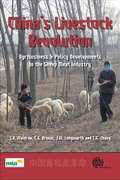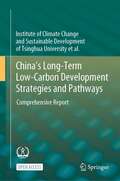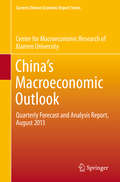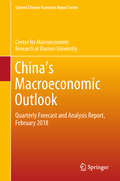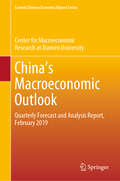- Table View
- List View
China's Global Political Economy: Managerial Perspectives (Routledge Studies on Comparative Asian Politics)
by Robert Taylor Jacques JaussaudMuch has been written about China’s economy, as well as its business management system. China's Global Political Economy, however, is designed to bring together these two perspectives, serving to enhance our understanding of China’s growing global role. Examining changes in the management strategies of foreign companies investing in China and Chinese enterprises doing business overseas, this book analyses China’s political economy in the context of the Communist Party’s changing policies. The introductory section begins by studying the aspects of Chinese economic growth as it impacts on domestic social issues and the projection of Chinese power abroad. Within this overall framework, it then goes on to critically assess the effects of foreign investment, business management strategies, human resource management, corporate social responsibility and the financial services sector. Arguing that the encouragement of consumption is a significant objective of the Chinese leadership, the last section is concerned with the importance of the food industry. This book will be of interest to students and scholars of Chinese business, management and international political economy, as well as policymakers and business practitioners.
China's Global Rebalancing and the New Silk Road
by B. R. DeepakThis collaborative volume discusses the One Belt One Road, or the New Silk Road, initiative of Chinese President Xi Jinping from the perspectives of the Belt and Road countries. This initiative has been viewed as a re-globalization drive by China in the backdrop of financial crisis of the West and the latter's increasingly protectionist tendencies of late. Rather than 'rebalancing' towards a certain region, this is supposed to be China's 'global rebalancing' aimed at inclusiveness and a win-win partnership. The initiative has raised hopes as well as suspicions about China's goals and intentions; that is, whether this is in sync with China's foreign policy goals, such as multipolarity, no hegemonic aspirations, and common security, or if this is an antidote to the U. S. foreign policy goals in the region, and China's ambition to realizing its long-term vision for Asian regional and global order. In this volume, a galaxy of eminent academics from India, China, Pakistan, Uzbekistan, Germany and Southeast Asia have critically analysed every aspect of this mammoth project, including the six major economic corridors identified by China for policy coordination, infrastructure connectivity, unimpeded trade, monetary circulation, and people to people exchanges. The authors have interpreted China's peripheral, regional as well as global diplomacy both over land and sea. This topical volume is of interest to scholars and students of Asian studies, China studies, Asian history, development studies, international relations and international trade.
China's Grain for Green Program: A Review of the Largest Ecological Restoration and Rural Development Program in the World
by Claudio O. Delang Zhen YuanThis book provides a comprehensive review of Grain for Green, China's nationwide program which pays farmers to revert sloping or marginal farm land to trees or grass. The program aims to improve the ecological conditions of much of China, and the socioeconomic circumstances of hundreds of millions of people. GfG is the largest reforestation, ecological restoration, and rural development initiative in history, combining the biggest investment, the greatest involvement, and the broadest degree of public participation ever. The book is organised in three sections. Part One reviews the history of land management in China from 1949 to 1998, exploring the conditions that led to the introduction of GfG, and comparing it to other reforestation programs. Part Two offers an overview of GfG, describing the timeline of the program, compensation paid to farmers, the rules concerning land and plant selection, the extent to which these rules were followed, the attitudes of farmers towards the program, and the way in which the program is organized and implemented by various state actors. Part Three discusses the impact of the GfG, from both ecological and socio-economic standpoints, looking at the economic benefits that result from participating in the GfG, the impact of the GfG across local economies, the redistribution of the labor force and the sustainability of the program, in particular the question of what will happen to the converted land when payments to farmers end.
China's Grand Strategy: A Framework Analysis
by Honghua MenThis book aims to build the ideal model of China's grand strategy framework, which is based on three key variables: national power, strategic concept and international institution. Taking the rise of China as an opportunity, this book adopts the assessment of national strategic resources as the beginning, focuses on the evaluation of strategic capability, the choice of strategic orientation, the establishment of strategic objectives, the planning of strategic content and the implementation of strategic means. Further, following this main line, this book establishes a China's grand strategy framework based on active participation and integration-transformation-shaping process. This book emphasizes that to achieve the goals of China's grand strategy; China should uphold this strategic attitude: It should not be seduced by praise and should not be made aggressive by criticism. It should learn to be glorious but remain humble, maintain a wealthy, influential but modest position by restraint. This book can be regarded as the essence of the author's 20 years long-term focus and research on the China's grand strategy. The author's postdoctoral tutor Professor Hu Angang’s comment of this book can hit the nail on the head: "This book is a pioneering theoretical study of China's great strategic research and makes a significant contribution to this research field. The basic arguments of this book have been submitted through various approaches to decision-making references or published in academic papers, and have received numerous positive responses and resonance. In my opinion, the basic ideas and important findings of this book will provide imperative reference to long-term strategy decision-making process. In addition, the fundamental theory and analysis method of the book will have an important influence in both domestic and international academic field."
China's Great Economic Transformation
by Thomas G. Rawski Loren BrandtThis landmark study provides an integrated analysis of China's unexpected economic boom of the past three decades. The authors combine deep China expertise with broad disciplinary knowledge to explain China's remarkable combination of high-speed growth and deeply flawed institutions. Their work exposes the mechanisms underpinning the origin and expansion of China's great boom. Penetrating studies track the rise of Chinese capabilities in manufacturing and in research and development. The editors probe both achievements and weaknesses across many sectors, including China's fiscal, legal, and financial institutions. The book shows how an intricate minuet combining China's political system with sectorial development, globalization, resource transfers across geographic and economic space, and partial system reform delivered an astonishing and unprecedented growth spurt.
China's Great Wall of Debt: Shadow Banks, Ghost Cities, Massive Loans and the End of the Chinese Miracle
by Dinny McMahon'One of the clearest and most thorough statements of an argument often made about the country: that its government has relied on constant stimulus to keep growth strong, an addiction that is bound to backfire. Second, he comes closer than any previous writer to covering the Chinese economy as Michael Lewis, the hugely popular author of The Big Short, might do. His analysis is informed but accessible, animated by anecdotes and characters, some colourful, some verging on tragic . . . McMahon is among the most compelling of the many analysts who conclude that China's economic miracle will end painfully' The EconomistThe world has long considered China a juggernaut of economic strength, but since the global financial crisis, the country's economy has ballooned in size, complexity, and risk. Once dominated by four state-owned banks, the nation's financial system is a tangle of shadow banking entities, informal financial institutions, and complex corporate funding arrangements that threaten growth, stability, and reform efforts. The country has accumulated so much debt so quickly that economists increasingly predict a financial crisis that could make 'Brexit' or Greece's economic ruin seem minor, and could undermine China's ascent as a superpower. Earlier this year, President Xi Jinping issued an urgent call for reform that gives the country until 2020 to transform its economy - a vaguely-defined objective that most economists agree is unrealistic. Whether or not China will be responsible for the next global recession, as some experts forecast, the fate of its economy will have far-reaching consequences for the rest of the world. Yet the inner workings of China's financial system are still very much a mystery to most outsiders. Now more than ever, as the country's slowing economy is being felt around the globe, it is essential to understand how China allowed its economy to become so mired in debt. China's Great Wall of Debt is a penetrating examination of the country's opaque financial system and the complex factors - demographic shifts; urbanization; industrialization; a pervasive over-reliance on debt-fueled investments - that have brought the country to the brink of crisis. Anchored by stories of China's cities and its people; from factory workers and displaced farmers to government officials and entrepreneurs, the narrative will take readers inside the country's ghost cities, zombie companies, start-ups, and regulatory institutions as McMahon explains how things got so bad, why fixing the problems is so hard, and what the economic outlook means for China and for the rest of us.
China's Great Wall of Debt: Shadow Banks, Ghost Cities, Massive Loans and the End of the Chinese Miracle
by Dinny McMahonThe world has long considered China a juggernaut of economic strength, but since the global financial crisis, the country's economy has ballooned in size, complexity, and risk. Once dominated by four state-owned banks, the nation's financial system is a tangle of shadow banking entities, informal financial institutions, and complex corporate funding arrangements that threaten growth, stability, and reform efforts. The country has accumulated so much debt so quickly that economists increasingly predict a financial crisis that could make 'Brexit' or Greece's economic ruin seem minor, and could undermine China's ascent as a superpower. Earlier this year, President Xi Jinping issued an urgent call for reform that gives the country until 2020 to transform its economy - a vaguely-defined objective that most economists agree is unrealistic. Whether or not China will be responsible for the next global recession, as some experts forecast, the fate of its economy will have far-reaching consequences for the rest of the world. Yet the inner workings of China's financial system are still very much a mystery to most outsiders. Now more than ever, as the country's slowing economy is being felt around the globe, it is essential to understand how China allowed its economy to become so mired in debt. China's Great Wall of Debt is a penetrating examination of the country's opaque financial system and the complex factors - demographic shifts; urbanization; industrialization; a pervasive over-reliance on debt-fueled investments - that have brought the country to the brink of crisis. Anchored by stories of China's cities and its people; from factory workers and displaced farmers to government officials and entrepreneurs, the narrative will take readers inside the country's ghost cities, zombie companies, start-ups, and regulatory institutions as McMahon explains how things got so bad, why fixing the problems is so hard, and what the economic outlook means for China and for the rest of us.
China's Great Wall of Debt: Shadow Banks, Ghost Cities, Massive Loans, and the End of the Chinese Miracle
by Dinny McMahonA stunning inside look at how and why the foundations upon which China has built the world’s second largest economy, have started to crumble.Over the course of a decade spent reporting in China as a financial journalist, Dinny McMahon came to the conclusion that the widely held belief in China’s inevitable economic ascent is dangerously wrong.In this unprecedented deep dive, McMahon shows how, lurking behind the illusion of prosperity, China’s economic growth has been built on a staggering mountain of debt. While stories of newly built but empty cities, white elephant state projects, and a byzantine shadow banking system have all become a regular fixture in the press, McMahon goes beyond the headlines to explain how such waste has been allowed to flourish, and why one of the most powerful governments in the world has been at a loss to stop it.Through the stories of ordinary Chinese citizens, McMahon tries to make sense of the unique—and often bizarre—mechanics of the nation’s economy, whether it be the state’s addiction to appropriating land from poor farmers; or why a Chinese entrepreneur decided it was cheaper to move his yarn factory to South Carolina; or why ambitious Chinese mayors build ghost cities; or why the Chinese bureaucracy was able to stare down Beijing’s attempts to break up the state’s pointless monopoly over table salt distribution.Debt, entrenched vested interests, a frenzy of speculation, and an aging population are all pushing China toward an economic reckoning. China’s Great Wall of Debt unravels an incredibly complex and opaque economy, one whose fortunes—for better or worse—will shape the globe like never before.
China's Growing Role in World Trade
by Robert C. Feenstra Shang-Jin WeiIn less than three decades, China has grown from playing a negligible role in world trade to being one of the world's largest exporters, a substantial importer of raw materials, intermediate outputs, and other goods, and both a recipient and source of foreign investment. Not surprisingly, China's economic dynamism has generated considerable attention and concern in the United States and beyond. While some analysts have warned of the potential pitfalls of China's rise--the loss of jobs, for example--others have highlighted the benefits of less expensive goods and services purchased by U.S. consumers along with new market and investment opportunities for U.S. firms. Bringing together an expert group of contributors, China's Growing Role in World Trade undertakes an empirical investigation of the effects of China's new status. The essays collected here provide detailed analyses of the microstructure of trade, the macroeconomic implications, sector-level issues, and foreign direct investment. This volume's careful examination of micro data in light of established economic theories clarifies a number of misconceptions, overturns some conventional wisdom, and documents data patterns that enhance our understanding of issues related to China's trade.
China's Growing Role in World Trade (National Bureau of Economic Research Conference Report)
by Robert C. FeenstraIn less than three decades, China has grown from playing a negligible role in international trade to being one of the world's largest exporters, a substantial importer of raw materials, intermediate outputs, and other goods, and both a recipient and source of foreign investment. Not surprisingly, China's economic dynamism has generated considerable attention and concern in the United States and beyond. While some analysts have warned of the potential pitfalls of China's rise—the loss of jobs, for example—others have highlighted the benefits of new market and investment opportunities for US firms. Bringing together an expert group of contributors, China's Growing Role in World Trade undertakes an empirical investigation of the effects of China's new status. The essays collected here provide detailed analyses of the microstructure of trade, the macroeconomic implications, sector-level issues, and foreign direct investment. This volume's careful examination of micro data in light of established economic theories clarifies a number of misconceptions, disproves some conventional wisdom, and documents data patterns that enhance our understanding of China's trade and what it may mean to the rest of the world.
China's Growth and Integration into the World Economy Prospects and Challenges
by Eswar PrasadA report from the International Monetary Fund.
China's Industrial Policies and the Global Business Revolution: The Case of the Domestic Appliance Industry (Routledge Studies on the Chinese Economy #Vol. 15)
by Ling LiuAs China has blended market reforms with comprehensive industrial policies, most research has focused on the national government's strategies for economic growth. However, one of the unique characteristics of industrial policy in China is that it involves government intervention at all levels, from the political elite all the way down to village leaders.This book focuses on the domestic appliance industry, and China's three major business groups in this area - Haier, Hisense and Aucma. The Haier Group, in particular, is one of the most successful and competitive enterprises in China and is very well-placed to compete globally as the Chinese economy becomes more integrated with the world trading system. This volume shows how industrial policy is formulated at the national level and implemented at the local level, and examines how local government frequently intervenes in local enterprises' business strategy and management.Of practical importance, this book provides academics, business people and policy makers with valuable insights into the development process and a concrete understanding of the challenges faced in the global business revolution by one of the world's most dynamic economies.
China's Industrial Technology: Market Reform and Organisational Change (UNU/INTECH Studies in New Technology and Development)
by Shulin GuOffering a comprehensive review of reform policy, followed by an examination of major approaches to institutional restructuring, Shulin Gu explores the way in which China's industrial technology has responded to economic reforms. At the heart of the work is the argument that market reform and organisational change are closely interdependent. Gu outlines the interaction of the two in China and reveals the damage which may result if market reform is not accompanied by new organisational design. Analysis of these issues is drawn from first-hand experience of Chinese technology systems, supported by insights from technological innovation economics and transaction cost economics.
China's Information Revolution
by Christine Zhen-Wei Qiang Christine Zhen-WeiSince 1997, China has devoted considerable resources to information and communications technology (ICT) development. China has the world's largest telecommunications market, and its information technology industry has been an engine of economic growth-growing two to three times faster than GDP over the past 10 years. E-government initiatives have achieved significant results, and the private sector has increasingly used ICT for production and service processes, internal management, and online transactions. The approaching 10-year mark provides an excellent opportunity to update the policy to reflect the evolving needs of China's economy. These needs include the challenges posed by industrialization, urbanization, upgraded consumption, and social mobility. Developing a more effective ICT strategy will help China to achieve its economic and social goals. Addressing all the critical factors is complex and requires long-term commitment. This book highlights several key issues that need to be addressed decisively in the second half of this decade, through policies entailing institutional reform, to trigger broader changes. This books is the result of 10 months of strategic research by a World Bank team at the request of China's State Council Informatization Office and the Advisory Committee for State Informatization. Drawing on background papers by Chinese researchers, the study provides a variety of domestic perspectives and local case studies and combines these perspectives with international experiences on how similar issues may have been addressed in other countries.
China's Innovation Economy: Artificial Intelligence and the New Silk Road (Routledge Studies in the Economics of Innovation)
by Jon-Arild JohannessenTwo trends will have more influence than anything else on the world’s future political and economic situation: the development of artificial intelligence and the emergence of China as a competitor to the United States on the international stage. This book is about the emerging innovation economy. It uses systems theory and evolutionary economics as a theoretical point of departure and explains why the focal point of the geopolitical stage is moving away from the alliance between the United States and Europe, and towards an alliance between China, the 14 Regional Comprehensive Economic Partnership countries, the countries along the new silk road, and Europe. The book argues that the globalization strategy of neoliberalism laid the foundation for the Chinese economic engine. Whereas the old globalization was driven by cost differences generally, and wage costs specifically, the new globalization is driven by divergence in competence in general, and technological competence in particular, and China’s primary goal is to develop artificial intelligence and intelligent robots. Further, the book posits that the interactions between the climate crisis and the new technology will change production, distribution and the creation of profits, both in China and more widely in the global innovation economy. The book develops a structure to describe, analyze and explain the Chinese innovation economy and contributes to the discussion regarding technological developments in China. The book is written for readers who are oriented towards the new globalization that is emerging in the innovation economy and the factors driving China's economic growth.
China's International Projection in the Xi Jinping Era: An Economic Perspective (SpringerBriefs in Economics)
by Lorenzo Bencivelli Flavia TonelliThis book illustrates the current state of China’s economic and trade relations from the perspective from different countries in the Xi Jinping era. The content is divided into five parts, the first of which traces the development of the Chinese economy starting with the reforms of the 1980s. The second part notes some distinctive elements of China’s positioning in the global economy, while the third describes the state of relations between the United States and China under the Trump presidency. The fourth part focuses on diplomatic and economic equilibria in East Asia, Central and Southern Asia, the Middle East, Africa and Latin America. In turn, the last part addresses relations between China and various European countries. Given its scope, the book is a must-read for economists, policymakers and professionals from around the globe, interested in a better understanding of China’s economic prospects in the Xi Jinping era.
China's Iron Ore Boom (Routledge Studies in the Growth Economies of Asia)
by Luke W. HurstChina’s emergence as the world’s second largest economy has been driven by more than four decades of explosive growth. To support this expansion, China has required massive expansion in its steel production capacity, which is highly correlated to its demand for iron ore imports. The scale and pace of China’s iron ore demand shock has pushed the global iron ore market into a historical adjustment. Using economic frameworks, this book brings to bare new data and field observations throughout Asia and Africa to investigate how the rapid growth in China’s iron ore demand has affected the organisation and structure of the global iron ore market. The research provides several important contributions to the extant literature including analysis of whether the Big Three Asian market iron ore exporters coordinated to sustain the profits arising from the price boom; estimating the financial impact of the Chinese state’s intervention in iron price negotiations; and addressing the concerns arising from the Chinese state’s provision of cheap financial support for its companies’ iron ore procurement. Offering unique insights into China’s economic rise and the structure of the iron ore market, this book will be relevant to students and scholars of resource economics, and the Australian and Chinese economies.
China's Labour Market, 1950–2050: The Role of Family Planning in Demographic and Income Transitions (Palgrave Studies in Economic History)
by Jane DuThis book presents an in-depth examination of China’s population control policies from their establishment to the present and explores the developing implications of these policies on the Chinese labour market. The book connects original research on contemporary Chinese demographics with a historical analysis of China’s labour market structure. Using data from the most recent population census, chapters explore the economic impact of the demographic transition that has taken place over recent decades, from the strict implementation of family planning policies to the current easing of these policies. The book examines income growth and economic development in China after the Second World War with comparative perspectives from other Asian countries including Japan and South Korea. It also devotes a chapter to regional variations in the effectiveness of population control policies, exploring differences in rural and urban areas, and surveys the future challenges for the Chinese government in addressing population and growth-related concerns. This book will be of interest to students and researchers in economic history, labour economics, and demography, as well as those interested in Chinese economic and societal development.
China's Lessons for India: The Political Economy of Change
by Sangaralingam RameshThis book and its companion volume offer a better understanding of the lessons that Indian policymakers can learn from China's economic experience over the last 40 years. The aim of the two books together is to evaluate China's incremental reforms and how these reforms have impacted on the Chinese economy, based on a classical rather than from a neoclassical perspective using a case study method. In this second volume, the author examines knowledge creation, knowledge spillovers and entrepreneurship across both China and India. The comparative study places the theoretical analysis of the previous volume in a real-world context of how China's economic reforms since 1978 have actually impacted on the country. Its real-world findings of the Chinese economy present a complete perspective on China's lessons for India as well as at a global context.
China's Lessons for India: The Political Economy of Development
by Sangaralingam RameshThis book and its companion volume offer a better understanding of the lessons that Indian policymakers can learn from China's economic experience over the last 40 years. The aim of the two books together is to evaluate China's incremental reforms and how these reforms have impacted on the Chinese economy, based on a classical rather than from a neoclassical perspective using a case study method. In this first volume, the author examines India's emergence from socialism and central planning as being in sharp contrast to China's experience, and considers how we might compare the institutional difference between the countries. It also covers a theoretical grounding for the comparison of the two largest populated countries in the world, which will be taken up by the second volume.
China's Livestock Revolution: Agribusiness and Policy Developments in the Sheep Meat Industry
by Scott Waldron Colin Brown John Longworth Zhang CungenThis book focuses on the growing sheep meat industry while drawing on associated research from other areas of the Chinese livestock section. Using this research, the authors use the sheep meat industry case study to illustrate the broader trends that apply more generally to the Chinese livestock sector, especially in the case of ruminant livestock.
China's Long-Term Low-Carbon Development Strategies and Pathways: Comprehensive Report
by Institute of Climate Change and Sustainable Development of Tsinghua University et al.This open access book introduces a multi-disciplinary and comprehensive research on China's long-term low-carbon emission strategies and pathways. After comprehensively considering China’s own socioeconomic conditions, policy design, energy mix, and other macro-development trends and needs, the research team has proposed suggestions on China’s low-carbon development strategies and pathways until 2050, with required technologies and policies in order to realize the goals of building a great modern socialist country and a beautiful China. These achievements are in conjunction with the climate goals set in the Paris Agreement alongside Global Sustainable Development. The authors hope that the research findings can serve as a reference for all sectors of Chinese society in their climate research efforts, offer support for the formulation and implementation of china’s national low-carbon development strategies and policies, and help the world to better understand China’s story in the general trend of global green and low-carbon development.
China's Macroeconomic Outlook: Quarterly Forecast and Analysis Report, August 2013 (Current Chinese Economic Report Series)
by China's Macroeconomic Outlook: Quarterly Forecast Analysis Report August 2013As the sluggish external market demand and excess domestic investment in past years have caused excess production capacity, resulting in both industrial growth rate and GDP growth rate falling to lowest point for the last three years in China. Where would China’s economy go? China’s Macroeconomic Outlook, August 2013 provides some insights into the details of the economic development in China, and also includes series of simulations of the impact of decreasing government revenue on the economic performance. The research suggests that China should cut its government revenue share in GDP to promote its structural adjustment.
China's Macroeconomic Outlook: Quarterly Forecast and Analysis Report, February 2018 (Current Chinese Economic Report Series)
by Center for Macroeconomic Research at Xiamen UniversityThis report is a partial result of the China’s Quarterly Macroeconomic Model (CQMM), a project developed and maintained by the Center for Macroeconomic Research (CMR) at Xiamen University. The CMR, one of the Key Research Institutes of Humanities and Social Sciences sponsored by the Ministry of Education of China, has been focusing on China’s economic forecast and macroeconomic policy analysis, and it started to develop the CQMM for purpose of short-term forecasting, policy analysis, and simulation in 2005.Based on the CQMM, the CMR and its partners hold press conferences to release forecasts for China’ major macroeconomic variables. Since July, 2006, twenty-three quarterly reports on China’s macroeconomic outlook have been presented and twelfth annual reports have been published. This report, the twenty-fourth quarterly report, has been presented at the Forum on China’s Macroeconomic Outlook and Press Conference of CQMM on February 27, 2018. This conference was jointly held at Beijing, China by Center for Macroeconomic Research at Xiamen University, and Economic Information Daily at Xinhua News Agency.
China's Macroeconomic Outlook: Quarterly Forecast and Analysis Report, February 2019 (Current Chinese Economic Report Series)
by Center for Macroeconomic Research at XiaThis report is a partial result of the China’s Quarterly Macroeconomic Model (CQMM), a project developed and maintained by the Center for Macroeconomic Research (CMR) at Xiamen University. The CMR, one of the Key Research Institutes of Humanities and Social Sciences sponsored by the Ministry of Education of China, has been focusing on China’s economic forecast and macroeconomic policy analysis, and it started to develop the CQMM for purpose of short-term forecasting, policy analysis, and simulation in 2005.Based on the CQMM, the CMR and its partners hold press conferences to release forecasts for China’s major macroeconomic variables. Since July, 2006, twenty-six quarterly reports on China’s macroeconomic outlook have been presented and thirteen annual reports have been published. This report, the twenty-sixth quarterly report, has been presented at the Forum on China’s Macroeconomic Outlook and Press Conference of CQMM on February 26, 2019. This conference was jointly held at Beijing by the CMR and the Economic Information Daily at Xinhua News Agency
